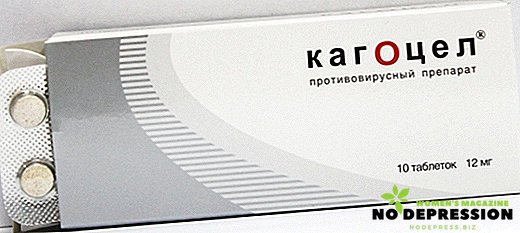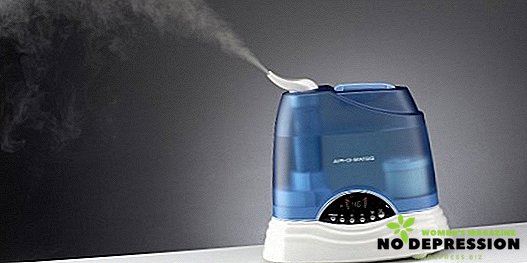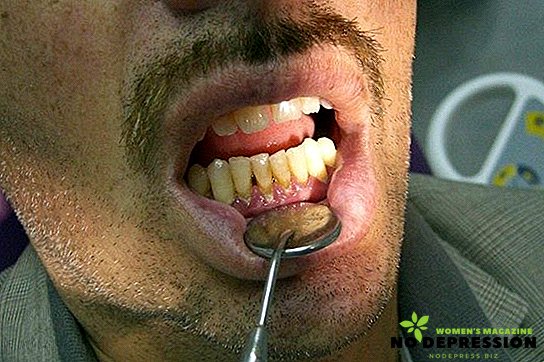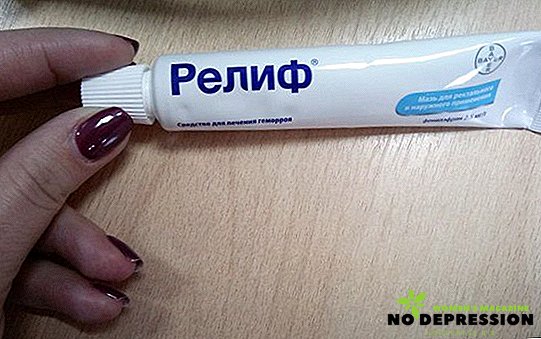The drug Kagocel is a biconvex tablet, the color varies from white to light brown with light patches. One tablet contains 12 mg of active ingredient. As part of the drug crospovidone, povidone, calcium stearate, potato starch and lactose monohydrate.

pharmachologic effect
Kagocel manifests itself as an antiviral agent of a new generation, belongs to a subgroup of low molecular weight inducers of the immune system. It has a complex chemical structure and is a heterochain polymer. Kagocel was synthesized on the basis of low-molecular natural polyphenol - gossypol (its content is 3%) and sodium carboxymethylcellulose.
When a viral infection, especially in combination with bacterial invasion (invasion), the immune response of the organism is greatly weakened, its reactivity is disturbed. The body, instead of mobilizing its reserves, ceases to actively fight the pathogen. Once in the body, Kagocel causes the formation of the so-called "late" interferon (a mixture of alpha- and beta-interferon), which is responsible for the antiviral immunity of the person.
Kagocel affects almost all cell populations of immune defense, ranging from macrophages and granulocytes to T and B lymphocytes, which not only normalizes the structure of the immune system, but also increases nonspecific resistance to bacterial infections.
Unlike exogenous (externally received) interferons, Kagocel stimulates the synthesis of its own immune cells, which are characterized by a more stable blood circulation (up to 4-5 days compared to several hours).
The dynamics of the concentration of interferons in the intestine does not coincide with the dynamics of the accumulation of interferons in the liquid fraction of blood. Synthesis of interferon in the bloodstream reaches a maximum after 48 hours from the start of the drug, and in the intestine only after 4 hours.
Pharmacokinetics
 When taking the drug inside the systemic circulation absorbs about 20% of the substance. In the blood, a large part of the drug is bound to proteins and lipids (37% and 47%, respectively), 16% remains in the unbound state.
When taking the drug inside the systemic circulation absorbs about 20% of the substance. In the blood, a large part of the drug is bound to proteins and lipids (37% and 47%, respectively), 16% remains in the unbound state.
High concentration of the drug is noted in the spleen, lymph nodes, liver, kidneys and thymus gland, low - in the heart, muscles, adipose tissue, genitals and blood plasma.
In the brain tissue, the drug almost does not accumulate, since a sufficiently large molecule of a substance cannot overcome the blood-brain barrier. For the removal of the drug from the body is mainly responsible intestine (90%) and kidneys (10%). Seven days after the last dose, about 88% of the received dose of the drug is excreted.
How to apply Kagocel to children and adults: indications and instructions
Indications for use:
- Treatment and prevention of SARS and influenza in adults and children.
- Treatment of infections caused by the herpes virus in adults.
The drug Kagocel has proven itself in the fight against ARVI, including in the complex treatment of influenza A and B with other antiviral and immunomodulatory drugs. Improves immunological indices with the addition of Oseltamivir in the treatment of viral pneumonia, including those caused by influenza A subtype H1N1. With SARS and uncomplicated forms of the influenza virus, monotherapy may be used.
Kagocel is successfully used to prevent ARVI and flu. In case of unfavorable epidemic situation in the region or in contact with a sick flu or ARVI, you should immediately begin a preventive course.
The drug is well tolerated, non-toxic (recognized as safe according to a large, multicenter, placebo-controlled study FLU-EE), no carcinogenic effect, embryotoxicity, adverse reactions are very rare.
Kagocel is ingested. Food intake does not affect the adsorption (absorption) of the drug.
For the treatment of influenza and acute respiratory viral infections, adults should take two doses three times a day on the first two days, and one tablet in the morning, afternoon and evening on the third and fourth day. The total duration is four days, will require 18 tablets.

The prophylactic course in adults ranges from a week to 1-2 months and is divided into seven-day cycles: the first and second day should be taken two tablets per day, followed by a 5-day break.
For the treatment of herpes virus, adults are prescribed for 5 days, 2 tablets three times a day. The total duration of treatment - 5 days, will require 30 tablets.
For the treatment of acute respiratory viral infections and infections caused by the influenza virus, children from 3 to 6 years old are prescribed for 2 days 1 tablet in the morning and evening, and in the next two days they take a tablet per day. The total duration of the course of treatment is four days, it will require 6 tablets.
Children over the age of 6 years for the treatment of acute respiratory viral infections and infections caused by the influenza virus are given one dose three times a day for 2 days, then one dose twice a day for 2 days. The total duration is four days, you will need 10 tablets.
The drug should be started no later than 4 days after the first symptoms of the disease appear. It is recommended to begin treatment within the first 48 hours of the disease.
Prevention of SARS and influenza virus in children aged 3 years and older is carried out in compliance with the 7-day cycles: the first days of the cycle are 1 tablet per day, followed by a 5-day break. The total duration of prevention is from one course to 1-2 months.
Contraindications
 Contraindications are as follows:
Contraindications are as follows:
- hypersensitivity or intolerance to any component of the drug;
- congenital lactase deficiency, hereditary lactose intolerance, malabsorption of various origins;
- suspicion of pregnancy or its established fact;
- lactation period (natural feeding);
- age up to 3 years.
Overdose, efficacy and other instructions for admission
Let's look at some features of the reception of this tool.
Effect on pregnancy, lactation
The effect on pregnancy, the lactation period has not yet been studied in detail, therefore, the drug should not be used in these cases.
Overdose
Cases of drug overdose have not been identified, if symptoms of intoxication occur, you should drink plenty of fluids, try to induce vomiting, and consult a doctor immediately.
special instructions
 The drug does not affect the control of the vehicle, does not cause drowsiness, goes well with various drugs, including immunomodulators, antibiotics, other antiviral drugs, has an additive (reinforcing) effect.
The drug does not affect the control of the vehicle, does not cause drowsiness, goes well with various drugs, including immunomodulators, antibiotics, other antiviral drugs, has an additive (reinforcing) effect.
In rare cases, when using the drug Kagocel allergic reactions are possible, with the development of which should immediately discontinue the drug and contact your doctor.
Only he can prescribe the right treatment.
Efficiency
According to the results of a randomized, placebo-controlled study, the use of the drug Kagocel resulted in more rapid elimination of flu symptoms. It is noted that a day after the start of Kagocel treatment, the temperature dropped to normal values in 70% of the subjects who received Kagocel, and only in 25% of patients from the placebo group. After 48 hours, 90% of patients in the main group had a normal body temperature, while 60% of patients from the control group remained elevated for 3-5 days.
Similar dynamics was noted for signs of intoxication (headache, depression, weakness, drowsiness, dizziness, muscle aches), which disappeared a day later in 63.2% and 20% of patients in the two groups, respectively.
Known analogues
Full analogue Kagocel does not exist. Among the drugs of similar effect registered and used in the Russian Federation, one can single out:
- Tiloron (Amiksin) - the drug of the first generation of immunomodulators. It has a wide therapeutic activity, is used to treat various viral and bacterial infections;
- meglumine acridone acetate (Cycloferon) is a derivative of acridine acetic acid, a low molecular weight inducer of interferon production. It has unproven efficacy and low safety profile;
- imidazolyl ethanamide pentanedioic acid (Ingavirin). A drug with high safety, inducer of leukotriene receptors;
- Viferon is a Russian drug based on human recombinant interferon alfa-2b. It is used only parenterally (intravenously) in a hospital.
As you see, Kagocel is a fairly common medicine, but it is very important to carefully read the instructions when taking it.












